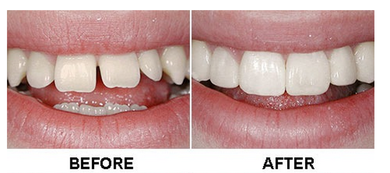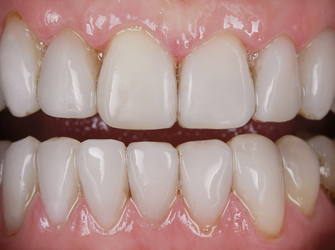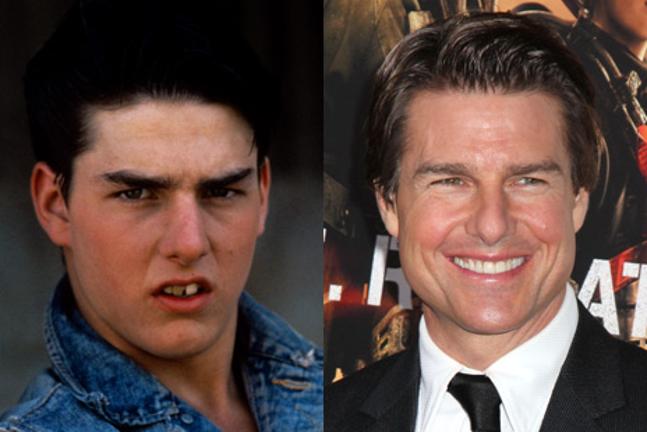What are veneers - Very thin layers of tooth coloured porcelain or tooth coloured filling material which are used to improve the appearance and/or function of a patients teeth. Dental veneers like veneers of any other kind usually just cover a layer on the visible surface of the tooth although they may overlap the edge of tooth and onto the back of tooth depending on the circumstances.
What materials are veneers made out of - they are made out of feldspathic porcelain usually which has a proven track record for veneers and can give an excellent lifelike appearance when done well. Alternatively they can be made out of high quality direct composite resin material. This is when they are made directly in your mouth as opposed to in a lab but these are very difficult to get looking as good as porcelain veneers unless your dentist is very experienced with this type of material.
How long do they last/should they last - if done properly and in the correct conditions then these should last 10 years or more. Their longevity is reduced in people that grind or clench their teeth (bruxers), people that dont look after their teeth or in cases where there is less tooth or less good quality tooth left to start with. Composite veneers will typically last half to 2/3's as long as porcelain veneers but each situation and patient is different so please ask your dentist about this.
Why are veneers done? - they are done less nowadays than they were 20-50 years ago as new materials and methods have developed. They are generally done to improve the appearance of the teeth(when decayed or chipped) or improve the alignment and appearance of the teeth (when they are crooked, crowded or spaced) either as a result of periodontal disease or naturally.
What to consider
1. Usually to ensure the veneer is not too thick or too thin and does not look false, a certain amount of teeth will need cutting back. This is less of a concern in a tooth which already has a large fracture or moderate decay in it but more of a concern in perfectly sound teeth or teeth with very minimal chips or decay.
2. If the chips are small or decay is minimal then a directly adhered tooth coloured composite material would be more suitable as it saves a lot of tooth from being cut away.
3. If the teeth are crowded or spaced then orthodontic movement is preferred to veneers in almost every situation. More recently dentists are moving towards an initial period of alignment of teeth with orthodontics followed by restoring the teeth with minimal veneers or direct composite restorations in order to improve the final appearance.
4. The decision to have veneers on teeth to improve the appearance should not be taken lightly as the removal of tooth structure is irreversible and once it is gone it is gone for good.
5. As veneers will need replacing then it must be considered that they may stain or look worse over time and more tooth structure will be removed each time they are replaced.
6. There is always a small risk when preparing a tooth (removing tooth structure) that the nerve inside this tooth will become inflamed or die off and need subsequent root canal treatment which greatly reduces the strength of that tooth.
7. The Orthodontic (braces) option prior to veneers may seem a costly treatment or over treatment but if it saves the majority of your tooth from being cut away and therefore gives a result that looks better, lasts longer and has much less potential for early replacement and complications then it must be considered a preferential option to veneers from the outset.
8. A staged approach of aligning your teeth first and whitening them may be enough to give you the result you want and in turn save you money and more importantly save all of the enamel on your teeth.
1. Usually to ensure the veneer is not too thick or too thin and does not look false, a certain amount of teeth will need cutting back. This is less of a concern in a tooth which already has a large fracture or moderate decay in it but more of a concern in perfectly sound teeth or teeth with very minimal chips or decay.
2. If the chips are small or decay is minimal then a directly adhered tooth coloured composite material would be more suitable as it saves a lot of tooth from being cut away.
3. If the teeth are crowded or spaced then orthodontic movement is preferred to veneers in almost every situation. More recently dentists are moving towards an initial period of alignment of teeth with orthodontics followed by restoring the teeth with minimal veneers or direct composite restorations in order to improve the final appearance.
4. The decision to have veneers on teeth to improve the appearance should not be taken lightly as the removal of tooth structure is irreversible and once it is gone it is gone for good.
5. As veneers will need replacing then it must be considered that they may stain or look worse over time and more tooth structure will be removed each time they are replaced.
6. There is always a small risk when preparing a tooth (removing tooth structure) that the nerve inside this tooth will become inflamed or die off and need subsequent root canal treatment which greatly reduces the strength of that tooth.
7. The Orthodontic (braces) option prior to veneers may seem a costly treatment or over treatment but if it saves the majority of your tooth from being cut away and therefore gives a result that looks better, lasts longer and has much less potential for early replacement and complications then it must be considered a preferential option to veneers from the outset.
8. A staged approach of aligning your teeth first and whitening them may be enough to give you the result you want and in turn save you money and more importantly save all of the enamel on your teeth.
Veneers cost
Porcelain veneers are rarely available on the National health Service and when they are come under band 3 in England and Wales (dental fees) and cost around £100 per veneer in Northern Ireland but require approval (which takes around 3 months) before they can be done. Even if done on the NHS they will only be available in standard materials and the appearance will not be the best available. Privately they will cost around £400 but this can range from £350-£1000 or so depending on where you go to have them done.
Summary
Veneers can be very destructive, especially if you have no or very minimal fillings in your front teeth to begin with.
Veneers will not last forever and typically will need replacing every 10 years.
Veneers can be done indirectly in porcelain or directly in composite resin material
Veneers can give an excellent result and aesthetic appearance.
Often Orthodontics prior to veneers is required or offered in order to limit the amount of tooth removal required for an acceptable result.
Veneers will not stop your teeth from decaying and in fact require greater looking after than even your natural teeth to avoid staining and tooth decay.
Veneers require a large area of good tooth to bond onto and so if this is not available then a crown will most likely be required in order to make a restoration that lasts.
Veneers may not be possible in people that grind their teeth as they are at high risk of fracture and alternative restoration methods may need to be sought.
Veneers can be very destructive, especially if you have no or very minimal fillings in your front teeth to begin with.
Veneers will not last forever and typically will need replacing every 10 years.
Veneers can be done indirectly in porcelain or directly in composite resin material
Veneers can give an excellent result and aesthetic appearance.
Often Orthodontics prior to veneers is required or offered in order to limit the amount of tooth removal required for an acceptable result.
Veneers will not stop your teeth from decaying and in fact require greater looking after than even your natural teeth to avoid staining and tooth decay.
Veneers require a large area of good tooth to bond onto and so if this is not available then a crown will most likely be required in order to make a restoration that lasts.
Veneers may not be possible in people that grind their teeth as they are at high risk of fracture and alternative restoration methods may need to be sought.
As we move further into the 21st Century patients must take responsibility for their own dental decisions and so need to make themselves as fully informed as possible before making any decisions. It is vital that you realise a staged approach may be in your best interest even if it takes longer or costs a little more in the first instance.
It is important to understand also the essential need to maintain as much or your tooth enamel and dentine (tooth substance) as possible and for as long as possible if you are going to keep your teeth into old age
In the same vain however it is important to understand that in some cases a little more tooth removal may be required in order to restore your tooth with something that will look good and last a long time as opposed to something that is doomed to fail, is compromised on appearance and which may put other parts of the tooth at greater risk of fracture in the future.
These are the questions you need to be asking yourself:
What exactly do I not like about my teeth?
1. Is it the shape - they maybe easily corrected with orthodontics and reshaping/addition of tooth coloured composite material
2. Is it the colour - whitening and polishing may be all that is needed
3. Is it old fillings, old veneers, old, crowns appearance - their careful replacement may be required but with possible risk of further tooth removal and subsequent root canal fillings.
4. Is it crowding or spacing of teeth - orthodontics or orthodontics followed by veneers may be suitable or direct closure of spaces with tooth coloured composite material
5. are they very worn/too small - build up directly with tooth coloured composite material or full coverage crowns may be required as if due to grinding/clenching then veneers are likely to just chip and fracture.
6. Do I show too much or too little gum - gum recontouring may bee all that is needed or this along with veneers
7. Is my gum level uneven - again gum recontouring may be required alone or with veneers
8. Anything else? - everything in between, if any further questions please click the button below.
What exactly do I not like about my teeth?
1. Is it the shape - they maybe easily corrected with orthodontics and reshaping/addition of tooth coloured composite material
2. Is it the colour - whitening and polishing may be all that is needed
3. Is it old fillings, old veneers, old, crowns appearance - their careful replacement may be required but with possible risk of further tooth removal and subsequent root canal fillings.
4. Is it crowding or spacing of teeth - orthodontics or orthodontics followed by veneers may be suitable or direct closure of spaces with tooth coloured composite material
5. are they very worn/too small - build up directly with tooth coloured composite material or full coverage crowns may be required as if due to grinding/clenching then veneers are likely to just chip and fracture.
6. Do I show too much or too little gum - gum recontouring may bee all that is needed or this along with veneers
7. Is my gum level uneven - again gum recontouring may be required alone or with veneers
8. Anything else? - everything in between, if any further questions please click the button below.
Celebrity Veneers
Compromised Results
Rylan Clark - TV presenter; Veneers here without orthodontics to align the teeth would be very destructive of tooth enamel and so orthodontics would always be recommended first. Some patients will prefer this look but in our opinion the teeth are too white and too uniform in colour and shape causing them to look false.
Natural Looking Results
|
|
|
We hope you enjoyed the article and will continue to take an active interest in your oral health as well as an active role in your dental decisions, any further questions please ask our dentists but clicking the button below:













 RSS Feed
RSS Feed